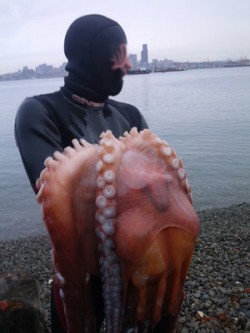Lesson Outline
December 30, 2013
 Dylan Mayer and the giant Octopus that caused so much controversy. Photo by Scott Lundy.
Dylan Mayer and the giant Octopus that caused so much controversy. Photo by Scott Lundy.When diver Dylan Mayer caught a giant Pacific octopus in Seattle’s Puget Sound, a controversy erupted. When pictures of Mayer’s catch hit the Internet, they caused an uproar among local environmentalists, who falsely believed the octopus was endangered and might eventually disappear from the Sound. The story and its aftermath were captured by Marnie Hanel, a journalist based in Portland, Oregon, in a New York Times Magazine feature article entitled “The Octopus that Almost Ate Seattle.”
Although the environmentalists' fears were misplaced – the giant Pacific octopus population is in fact robust and the animal is routinely enjoyed by diners at a trendy ‘locavore’ restaurant favored by Seattle’s “food community” – the story offers a great window into some key News Literacy concepts, including balance, fairness and bias, as an interview conducted by Center for News Literacy Director Dean Miller with both author Marnie Hanel and her editor, Jon Kelly, revealed.
Audio Clips
READER BIAS
Journalist Marnie Hanel first describes the inherent bias in the reader.
[audio mp3="/sites/default/files/wp-uploads/2013/12/Marnie_BiasRecut.mp3"][/audio]
Editor Jon Kelly followed up on the discussion of the reader's bias brought to the story.
[audio mp3="/sites/default/files/wp-uploads/2013/11/Jon_Bias_Followup.mp3"][/audio]
Ms. Hanel goes on to describe the evidence of reader’s cognitive dissonance through the reader comments.
[audio mp3="/sites/default/files/wp-uploads/2013/12/Marnie_Provisionaltruth_RECUT.mp3"][/audio]
RELATED NEWS LITERACY CONCEPTS EXPLORED IN THIS ARTICLE:
POWER OF IMAGES
Ms. Hanel describes how professional images of Dylan Mayer’s catch played a critical role in the spread of the story.
[audio mp3="/sites/default/files/wp-uploads/2013/12/PowerOfImage_Recut.mp3"][/audio]
LESSON GUIDING QUESTIONS:
- Define "Inherent Bias". How might it affect a reader of this story? Give an example.
- Think about what you may have thought about this story before you read it -- how might your own assumptions about it change your perceptions of the characters? the scenario?
- As you read the piece, how did your perceptions of each of the characters change?
- If reading the story from the NYtimes.com website, how do the comments reflect the views of the readers? What seems to be the consensus of the comments? Were there any commenters whose views may have swayed others?
ADDITIONAL RESOURCES:
This article from Scientific American talks about how fears that the actions of the diver might not have been ethical may have caused much of the controversy. (It also wryly notes, “You’re never going to win an arms race with an octopus.”)
And this story from a local newspaper lends more perspective on what happened: critics commented online that “they wished someone would tie weights around her son and sink him.”
Read the full piece here: The Octopus That Almost Ate Seattle - NYTimes.com
-
0 comments
-
1 save
-
Share
